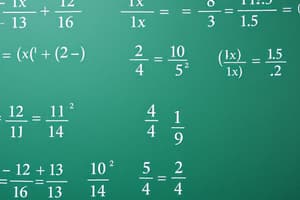Podcast
Questions and Answers
What is an algebraic fraction?
What is an algebraic fraction?
Fraction with algebraic terms and expressions in the denominator and/or numerator.
Calculate $\frac{2x}{5} + \frac{4y}{5}$?
Calculate $\frac{2x}{5} + \frac{4y}{5}$?
$\frac{2x + 4y}{5}$
What is the LCD of $\frac{3x}{10}$ and $\frac{2y}{15}$?
What is the LCD of $\frac{3x}{10}$ and $\frac{2y}{15}$?
30
Convert $\frac{2x}{7}$ to an equivalent fraction with a denominator of 21.
Convert $\frac{2x}{7}$ to an equivalent fraction with a denominator of 21.
What does $\frac{3x}{11} + \frac{5x}{11}$ equal?
What does $\frac{3x}{11} + \frac{5x}{11}$ equal?
What does $\frac{4a}{3} + \frac{2a}{5}$ equal?
What does $\frac{4a}{3} + \frac{2a}{5}$ equal?
What does $\frac{6k}{5} - \frac{3k}{10}$ equal?
What does $\frac{6k}{5} - \frac{3k}{10}$ equal?
Flashcards are hidden until you start studying
Study Notes
Algebraic Fractions
- An algebraic fraction is defined as a fraction that includes algebraic terms in either the numerator or the denominator.
Adding Algebraic Fractions
- Example of calculating the sum: ( \frac{2x}{5} + \frac{4y}{5} ) simplifies to ( \frac{2x + 4y}{5} ).
- When adding fractions with the same denominator, simply combine the numerators.
Least Common Denominator (LCD)
- The LCD of ( \frac{3x}{10} ) and ( \frac{2y}{15} ) is 30, determined by identifying the least common multiple (LCM) of the denominators 10 and 15.
Converting Fractions
- To convert ( \frac{2x}{7} ) into an equivalent fraction with a denominator of 21, multiply both numerator and denominator by 3, resulting in ( \frac{6x}{21} ).
Example of Adding Fractions with Different Denominators
- For ( \frac{4a}{3} + \frac{2a}{5} ):
- Identify the LCD (15).
- Convert each fraction:
- Multiply ( \frac{4a}{3} ) by ( \frac{5}{5} ) to get ( \frac{20a}{15} ).
- Multiply ( \frac{2a}{5} ) by ( \frac{3}{3} ) to get ( \frac{6a}{15} ).
- Summing gives ( \frac{26a}{15} ).
Example of Subtracting Fractions
- To solve ( \frac{6k}{5} - \frac{3k}{10} ):
- Identify the LCD as 10.
- Convert ( \frac{6k}{5} ) by multiplying by ( \frac{2}{2} ) to get ( \frac{12k}{10} ).
- Proceed with subtraction: ( \frac{12k}{10} - \frac{3k}{10} = \frac{9k}{10} ).
Key Takeaways
- Always identify the LCD when adding or subtracting algebraic fractions.
- Convert fractions to have the same denominator before performing operations.
- Simplifying the final result is important after calculations.
Studying That Suits You
Use AI to generate personalized quizzes and flashcards to suit your learning preferences.




